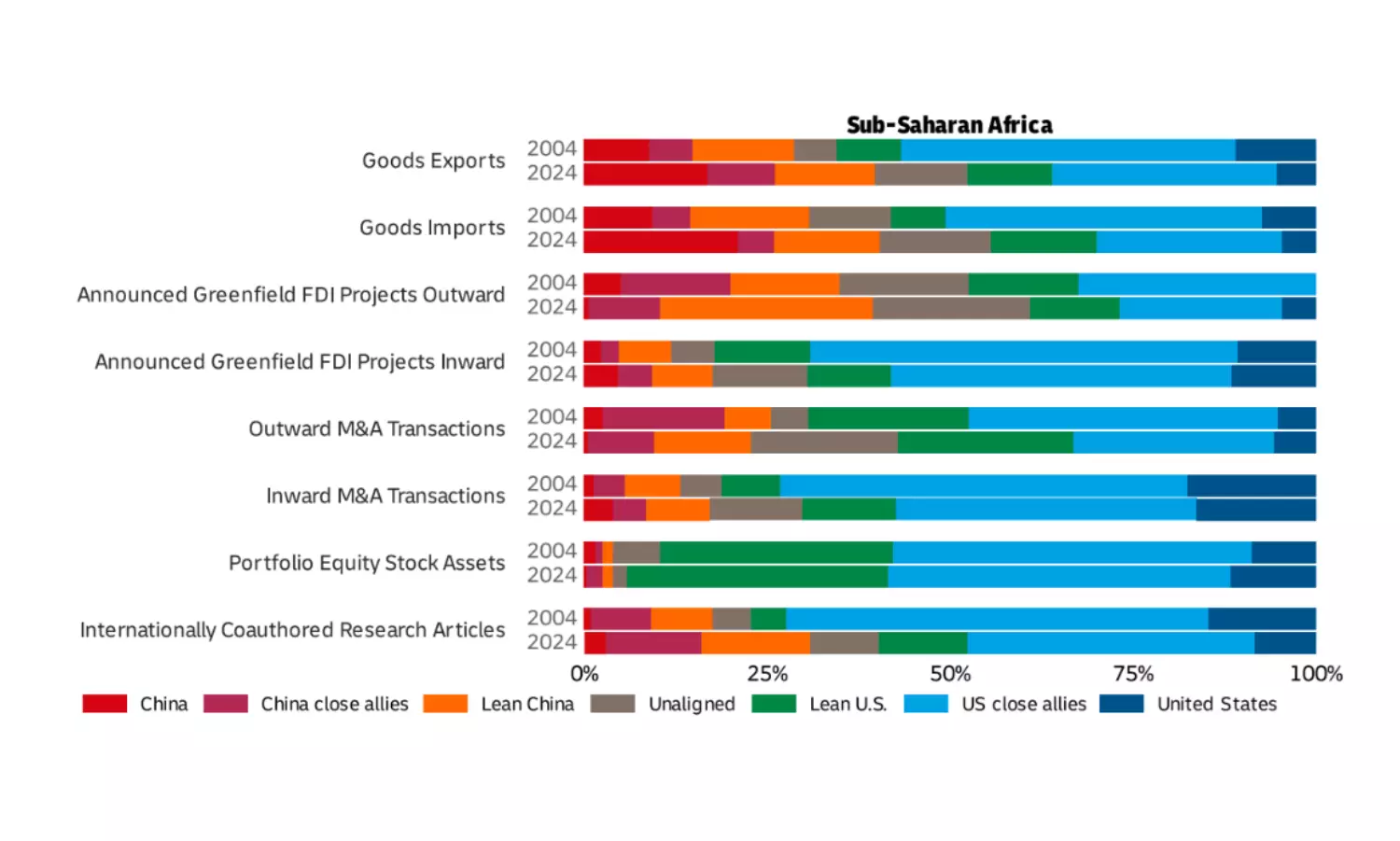Africa posts fastest trade growth as globalisation holds at record high
Sub-Saharan Africa’s exports surge; global trade defies tariff turbulence, maintaining long-distance reach

Sub-Saharan Africa summary profile of international flows by geopolitical alignment. Sources: Capital Economics; Clarivate Web of Science; Financial Times fDi Markets database; IMF CPIS database; IMF DOT Database; SDC Platinum
Globalisation is holding firm—and Africa is helping drive that resilience. Despite the steepest surge in U.S. tariffs since the 1930s, global trade continues to expand and business investment abroad remains steady, according to the latest DHL Global Connectedness Tracker by DHL and NYU Stern.
The report projects global trade to grow 2.5% annually through 2029, matching the past decade’s pace, while Sub-Saharan Africa stands out with the world’s fastest trade value growth in early 2025. Export-led momentum from markets such as Ghana, Zambia, and Senegal underscores Africa’s rising role in global commerce.
Source: IMF International Trade in Goods (IMTS)
The update offers the first systematic assessment of how international trade and business investment are reacting to shifting U.S. trade policy under President Trump’s second term, according to a release from DHL. The Tracker is a concise report and interactive website that provides regular updates on globalisation and global trade. It complements the DHL Global Connectedness Report, published regularly since 2011. "This edition draws on over 20 million data points from more than 25 sources to provide a comprehensive overview of the changing landscape of globalisation and global trade," it reads.
Sub-Saharan Africa emerged as one of the standout performers in the DHL Global Connectedness Tracker 2025 Special Update, achieving the world’s fastest trade value growth in the first half of 2025. The region’s surge was driven primarily by exports, with top performers including Ghana, Zambia, Côte d’Ivoire, the Democratic Republic of Congo, and Senegal.
Trade lanes such as DRC–South Africa and Ghana–South Africa recorded the sharpest growth.
The Tracker forecasts Sub-Saharan Africa’s trade volumes to grow at an average annual rate of 4.3% through 2029—the second-fastest in the world, behind only South & Central Asia. While this is a slight downgrade from earlier projections (5.3%), it still represents a significant acceleration from the post-pandemic period.
Sources: DHL Trade Atlas composite forecast based on IMF World Economic Outlook; Economist Intelligence Unit; Oxford Economics Global Data; S&P Global Market Intelligence
Export intensity continues to rise, with services driving growth since 2022, and regional trade ties strengthening across most sectors. However, Africa remains one of the least regionally concentrated trading regions—only 19% of trade stays within the continent, with goods travelling an average distance of over 7,000 km, underscoring its deep integration into global markets.
Sources: CEPII Gravity database; IMF International Trade in Goods; UN Comtrade database
Despite rising engagement with China and its allies, Africa still conducts more total international activity with the U.S. and its close partners, reflecting its balanced global positioning.
Global trade on track to match growth rate of previous decade through 2029
On a global level, trade is projected to keep growing. The Tracker’s composite forecast projects a 2.5% annualised growth rate in global trade volumes from 2025 to 2029 – roughly matching the pace of the previous decade. One reason why trade can continue growing even as the U.S. raises tariffs is that only 13% of global goods imports went to the U.S. in 2024 and 9% of exports came from the U.S. Another is that most countries have not followed the U.S. in implementing broad tariff increases.
“Despite all the headwinds, the DHL Global Connectedness Tracker highlights the enduring strength of global trade,” said John Pearson, CEO DHL Express. “Trade barriers do not serve the world’s best interests. But we must never underestimate the creativity of buyers and sellers around the world who want to do business with each other. At DHL, we’re ready to help our customers seize the countless trade opportunities that continue to emerge across international markets.”
Source: Economist Intelligence Unit, IMF World Economic Outlook Database, Oxford Economics Global Data, S&P Global Market Intelligence
Tariffs are slowing, not stopping trade growth
While U.S. tariffs are predicted to slow global trade growth, they are not expected to stop it. Before the current wave of tariff increases (in January 2025), global goods trade volume was forecast to grow at a 3.1% annualised rate over the 2025 to 2029 period – since downgraded to 2.5%. North America experienced the steepest downgrade, with projections falling from 2.7% in January 2025 to just 1.5% by September. Most other regions experienced smaller downward revisions.
In contrast, forecasts were upgraded for South & Central America and the Caribbean, as well as the Middle East & North Africa. Most countries in these regions face relatively small U.S. tariff increases, and Middle East trade is expected to benefit from increased oil production and exports.
Source: DHL Trade Atlas composite forecast based on IMF World Economic Outlook, Economist Intelligence Unit, Oxford Economics Global Data, S&P Global Market Intelligence
Global trade defies tariff turbulence in first half of 2025
The DHL Global Connectedness Tracker also reveals that, in the first half of 2025, international trade grew faster than in any half-year since 2010, excluding the pandemic rebound. U.S. imports surged early in 2025 as buyers rushed to frontload purchases ahead of tariff hikes. China fully offset declining exports to the U.S. with increased shipments to the ASEAN (Association of Southeast Asian Nations) region, while also substantially growing its exports to Africa, the EU, and other markets. Even after the frontloading wave in the U.S. subsided, global trade volumes remained above prior-year levels.
Source: CPB World Trade Monitor
Globalisation holds at record high levels
The report also measures the wider phenomenon of globalisation based on trade, capital, information, and people flows. It uses a scale running from 0% (no flows across national borders) to 100% (borders and distance have no impact). Currently, the global level stands at 25% – nearly unchanged since its record high in 2022.


